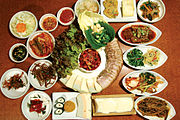Bossam
hand | |
| Korean name | |
| Hangul | 보쌈 |
|---|---|
| Hanja | 褓쌈 |
| Revised Romanization | bossam |
| McCune–Reischauer | possam |
| IPA | [po.s͈am] |
Bossam (
Bossam is a popular dish in South Korea, often served as anju (i.e. food accompanying alcoholic drinks).[4] To eat, the meat and side dishes are wrapped together in ssam vegetables, hence the literal meaning of bossam: "wrapped" or "packaged".
History
Bossam is traditionally linked with the process of gimjang, during which large quantities of kimchi are prepared for winters.[5] To ensure the commitment of the workers during this labor-intensive process, yangban (scholar-gentry of the Joseon era) would deliver a pig for a feast.[5] The workers would enjoy boiled pork with some of their newly made kimchi, which, being early in the fermentation process, was a fresh and crispy complement to the soft pork of bossam.[5]
Preparation
Although beef can also be used, pork is preferred for bossam.
If the meat is served with fresh raw oyster, the dish is called gul-bossam (굴보쌈; "oyster bossam").[5]
Gallery
-
Bossam
-
Gul-bossam (bossam with oysters)
-
Bossam table with banchan (side dishes)
See also
References
- ^ Sifton, Sam (12 January 2012). "The Bo Ssam Miracle". The New York Times. Retrieved 5 April 2013.
- Korean Food Foundation (in Korean). Retrieved 27 May 2017.[permanent dead link]
- ^ Jung, Alex (11 November 2011). "5 Korean ways to eat a pig". CNN. Retrieved 11 April 2012.
- ^ Lee, Cecilia Hae-Jin (29 April 2015). "Koreatown's Mr. Bossam serves bossam -- and spicy ribs with cheesy corn". Los Angeles Times. Retrieved 27 May 2017.
- ^ a b c d "Jongno 3(sam)-ga`s Gul Bossam Alley". Visit Seoul. Seoul Metropolitan Government. 28 November 2011. Retrieved 16 April 2013.
- ^ Doopedia (in Korean). Doosan Corporation. Retrieved 27 May 2017.
- ^ "보쌈". terms.naver.com (in Korean). Retrieved 2021-06-07.
External links
 Media related to Bossam at Wikimedia Commons
Media related to Bossam at Wikimedia Commons



